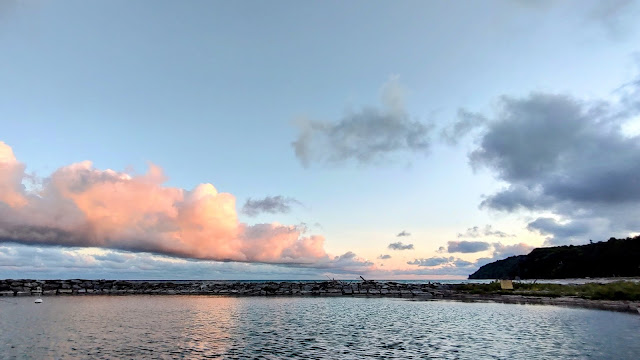Amy Marie Visits: The Day the Diesel Died...
Every boater dreads the day their trusty diesel quits singing its sweet tune. We experienced this once before in a boat with twin diesels. Much less drama as you can easily travel on a single engine. Amy Marie is equipped with one diesel, any unexpected stoppage is cause for concern. Especially when you are in the middle of a bay in Desolation Sound with eight hundred feet of water under the keel. You can't just drop the anchor and begin troubleshooting. You drift at the whim of the currents and wind.
Once a diesel is running, only one thing will cause it to cease operation. That is the lack of fuel. Combustion occurs as the piston compresses air to a temperature sufficient to ignite the diesel fuel that is injected into the combustion chamber. Our task was to discover why the engine was experiencing fuel starvation. The most common reason is contaminated fuel which can cause fuel filters to become clogged and prevent fuel from reaching the engine. We changed the fuel filters. The engine did not re-start. The investigation would take some time and we were drifting further from a safe place to do more troubleshooting.
We launched the dinghy, attached her to the aft hip of Amy Marie and used the dinghy motor to propel us to Refuge Cove. Our dinghy motor is not powerful, but it was adequate to move us steadily toward the dock.
Further examination indicated that the electric fuel pump was not functioning. I did not have a spare onboard and online investigation coupled with cell phone calls indicated it would be difficult to find and lead times would be long. The staff and other boaters at Refuge Cove were quite helpful. We needed to get the boat to a port better equipped to deal with this type of problem.
We invoked the C-Tow Option. C-Tow, as the name implies, is a tow boat to get you to where you need to go. Fortunately, our insurance covers this service. The nearest port was Powell River, 25 miles away. The C-Tow skipper was quite skilled. He quickly attached the tow harness and we got underway for the 4 hour trip south.
The weather was excellent. Consequently, the tow was an easy and uneventful experience.
While underway to Powell River, the C-Tow Skipper called a diesel mechanic he knew. The fellow came to Amy Marie and confirmed my diagnosis that the fuel pump was not functioning. The sun was setting so no further work could be undertaken.
The next morning, I checked to see if power was being supplied to the fuel pump. The Volt/Ohm Meter indicated no power. Perhaps the fuel pump was not bad, and the problem was electrical. Working backward on the electrical supply side, I found a relay in the engine control unit (ECU) that energized the fuel pump as soon as the engine was turned on. Fortunately, I had a spare relay onboard. I removed the suspect relay, inserted the new one, and with a turn of the key, the engine started and purred as normal!
To say we were both happy would be an understatement. It was such a relief to know that the repair process would not be expensive or time-consuming. Our engine is a Yanmar, and while there are Yanmar dealers in Canada, they no longer have a Canadian parts distribution network. During the troubleshooting process we called two Yanmar dealers and did not receive a return call from either. It was clear that if we could not solve the problem ourselves, it would be a lengthy process.
I do have to mention the value of the Tugnuts Bulletin Board. This is an online bulletin board for Ranger Tug Owners to discuss issues associated with the care and maintenance of their boats. I had read a couple of years earlier of an owner that had the fuel injector pump relay fail. At that time, I added two of the relays to my spare parts kit as they were inexpensive. Then I forgot about them until this situation. Thanks Tugnuts! Your willingness to share your experience and knowledge was put to effective use. I also benefited from live conversations with two Ranger Tug R27 Classic owners who generously shared their experience with fuel starvation and the remedies they enacted.
The story ended well. We had two high anxiety days, but worked through it and resumed our summer of cruising the Pacific Northwest. We were blessed to find a myriad of people who offered advise, counsel, and help throughout the process. For this assistance we are grateful. Boaters are the best!
__________________________________________________________________________












So scary. Glad you were able to get back on the move again so soon.
ReplyDeleteThanks, us too!
DeleteWe had a similar experience. Ours occurred 20 minutes after launching and we were just off Quonset Point in Narragansett Bay. We dropped anchor. After confirming fuel pump was working and installing a fresh fuel filter but still starving for fuel we gave up and did a hip tow back to the boat ramp. Cause of starvation was a clogged fuel pick up line in the fuel tank. Who the hell puts a non-serviceable filter in an inaccessible location?
ReplyDeleteI checked the screen on the pickup tube too. I had high hopes for a clogged screen but it was clean. Guess it is meant to keep the large chunks from getting sucked up. I agree, the location was not easy to access.
DeleteHi Beth and Mike! Rich and Laura from PYC here. I just found your blog!! Wow! What an adventure. Looking forward to reading it from the start. We’re glad you two are out there “doing it.” Safe travels!!
ReplyDelete